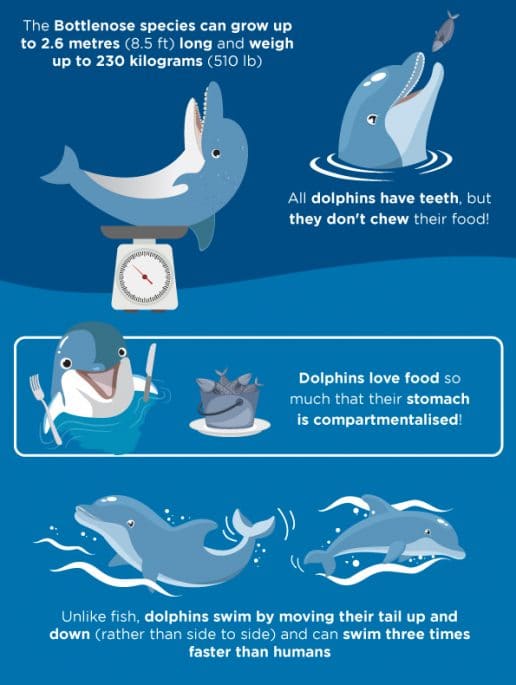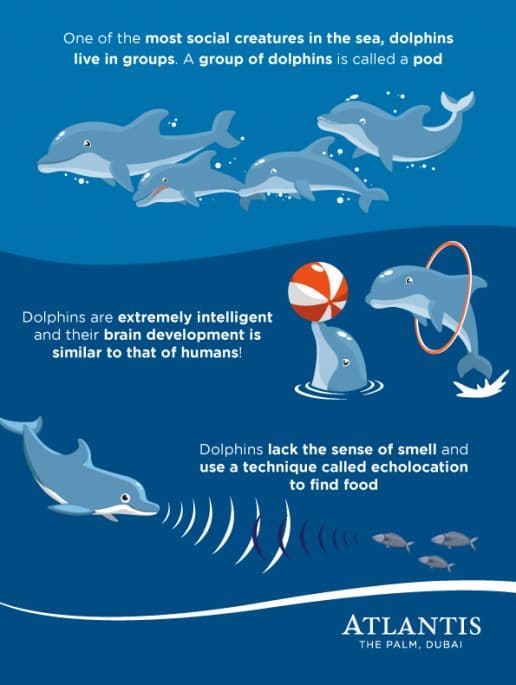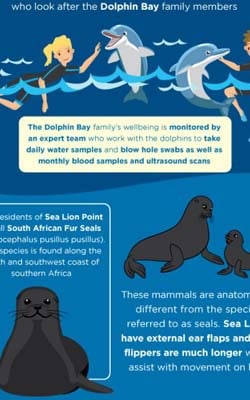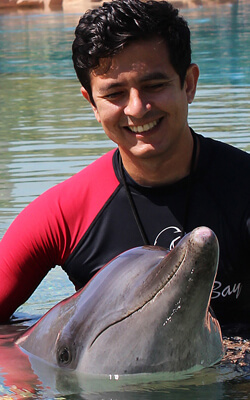
Top Facts About Dolphin Bay at Atlantis, The Palm
Is there anything more adorable than a dolphin? Here we’ve rounded up ten interesting facts about these amazing creatures that live at Dolphin Bay, a sophisticated marine mammal conservation and educational habitat for dolphins in Atlantis, The Palm:

1. Dolphin Bay is Atlantis The Palm’s prime development in dolphin care and protection and the first of its kind to be created in the Middle East
As one of the most sophisticated dolphin habitats in the world, Dolphin Bay offers our friendly creatures a secure environment to live and breed. A responsible code of conduct is followed that enhances their longevity and quality of life, as they are protected from elements that affect their survival in their natural habitat, including interactions with commercial and recreational fishing, oil spills, biotoxins, diseases, drought, environmental pollution, flood, fire, and predators.

2. Dolphin Bay features one of the most intelligent marine animals and showcases five different animal experiences in its three interactive lagoons
The most prominent Dolphin interaction and a guest favourite is the
Dolphin Adventure. The experience allows you to step into deeper waters and discover the wonders of swimming alongside these unique creatures.
3. Dolphin Bay holds more than 26 million litres of water and has the finest quality silica sand imported from Saudi Arabia
High grade silica from the Kingdom of Saudi Arabia was used in the construction of the eco-friendly dolphin sanctuary.
4. The Bottlenose species can grow up to 2.6 metres (8.5 ft) long and weigh up to 230 kilograms (510 lb)
What makes a Bottlenose dolphin different from a common bottlenose? Generally, they are smaller, have a longer rostrum or sprout, and have spots on their belly and lower sides.

5. All dolphins have teeth, but they don’t chew their food!
Although they have 23 to 29 teeth on each side of their jaws, the Bottlenose dolphins do not chew their food. The main purpose of their teeth is to catch their prey and then swallow it. They swallow their prey head first but If their prey is too big they will use their teeth to shred it into smaller pieces which then allows them to swallow.
6. Dolphins love food so much that their stomach is compartmentalised!
They have a total of three compartments or chambers, the first is a receiving chamber, the second does the chemical breakdown and the third regulates the flow of digested food into the intestine.
7. Unlike fish, dolphins swim by moving their tail up and down (rather than side to side) and can swim three times faster than humans
Dolphins can swim three times faster than humans, at a speed of up to 25 miles per hour. That’s nearly as fast as Usain Bolt!

8. One of the most social creatures in the sea, dolphins live in groups. A group of dolphins is called a pod
Most Bottlenose dolphins are highly sociable and often can be seen as part of a pod (group). These pods of dolphins hunt, play and help protect each other.
9. Dolphins are extremely intelligent and their brain development is similar to that of humans!
Dolphins have very big brains! They have an absolute brain mass of 1500-1700 grams. This is slightly greater than that of humans (1300-1400 grams) and about four times that of chimpanzees (400 grams). Only one side of the dolphin’s brain sleeps at a time, this allows them to be able to breathe and to be able to be alert to threats even while they are resting.
10. Dolphins lack the sense of smell and use a technique called echolocation to find food
Due to the absence of olfactory bulbs and olfactory nerves in the brain, dolphins use a complex system of echolocation to navigate their surroundings and hunt their prey. Echolocation is the process of listening for the returning echoes from high-pitched sounds bounced off by objects in a given space. What’s more! Dolphins have the ability to hear sounds within the frequency range of 1-150 kHz (almost 10 times that of humans).
Like these facts? Take a look at the full Atlantis’ Dolphin Bay Facts Infographic.



